Featured Text
Alexander Calder
The Artist’s Voice: Talks with Seventeen Artists. New York and Evanston, Illinois: Harper & Row, 1962.
The Artist’s Voice: Talks with Seventeen Artists. New York and Evanston, Illinois: Harper & Row, 1962.
Question: Does your work satirize the modern machine?
Calder: No, it doesn’t. That’s funny, because I once intended making a bird that would open its beak, spread its wings and squeak if you turned a crank, but I didn’t because I was slow on the uptake and I found that Klee had done it earlier with his Twittering Machine and probably better than I could. In about 1929, I did make two or three fish bowls with fish that swam when you turned a crank. And then, of course, you know about the Circus. I’ve just made a film of it in France with Carlos Vilardebo.
Question: Which has influenced you more, nature or modern machinery?
Calder: Nature. I haven’t really touched machinery except for a few elementary mechanisms like levers and balances. You see nature and then you try to emulate it. But, of course, when I met Mondrian I went home and tried to paint. The basis of everything for me is the universe. The simplest forms in the universe are the sphere and the circle. I represent them by disks and then I vary them. My whole theory about art is the disparity that exists between form, masses and movement. Even my triangles are spheres, but they are spheres of a different shape.
Question: How do you get that subtle balance in your work?
Calder: You put a disk here and then you put another disk that is a triangle at the other end and then you balance them on your finger and keep on adding. I don’t use rectangles—they stop. You can use them; I have at times but only when I want to block, to constipate movement.
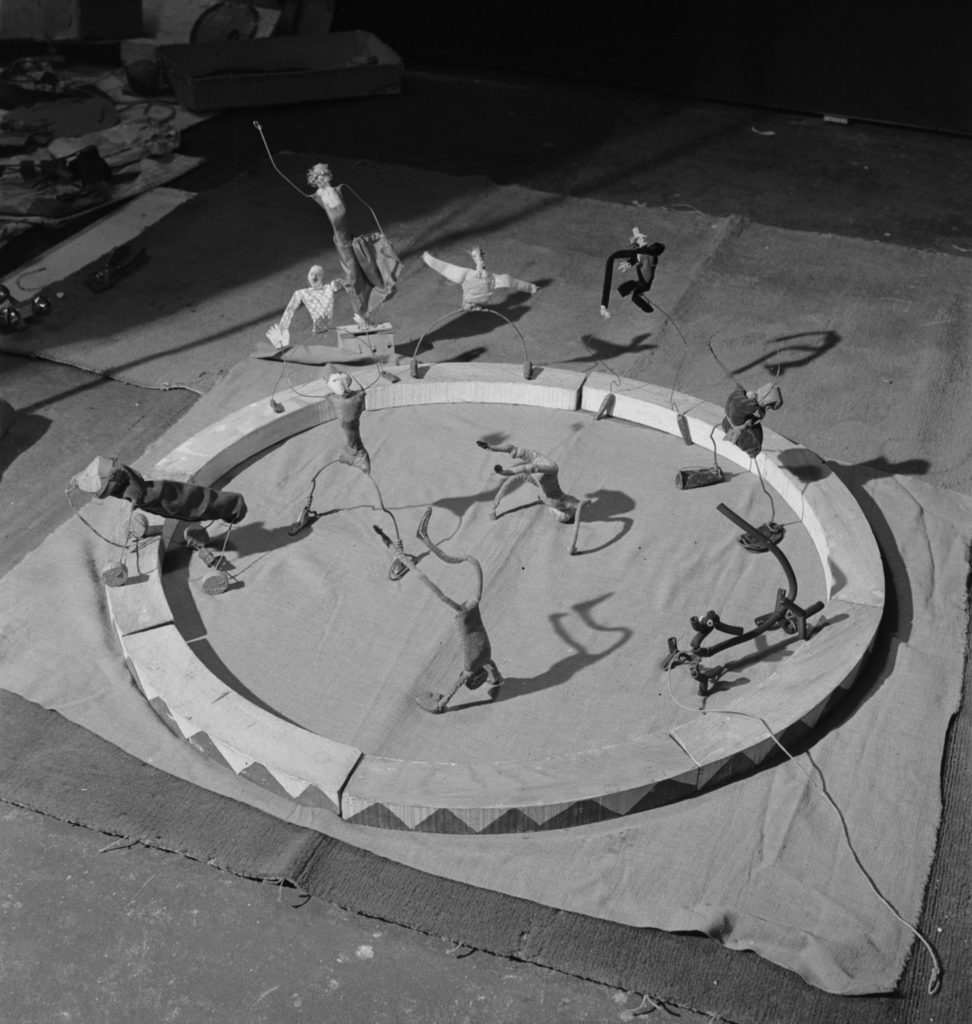
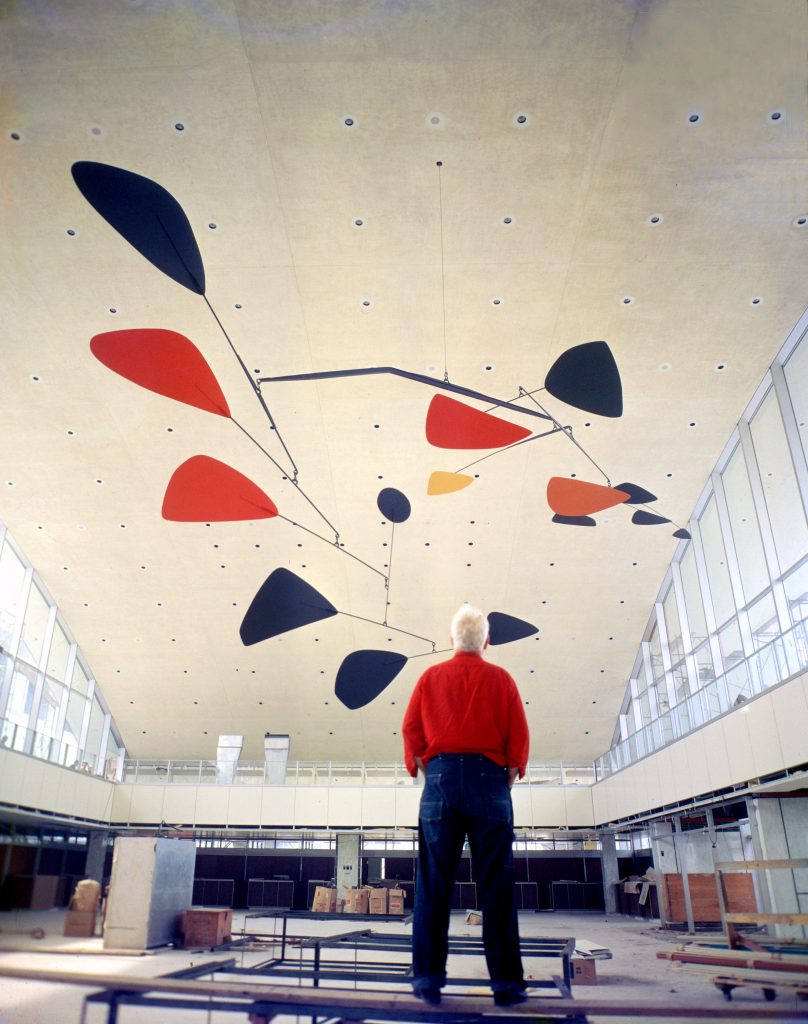

Question: Is it true that Marcel Duchamp invented the name “mobile” for your work?
Calder: Yes, Duchamp named the mobiles and Arp the stabiles. Arp said, “What did you call those things you exhibited last year? Stabiles?”
Question: Were the mobiles influenced by your Circus?
Calder: I don’t think the Circus was really important in the making of the mobiles. In 1926 I met a Yugoslav in Paris and he said that if I could make mechanical toys I could make a living, so I went home and thought about it awhile and made some toys, but by the time I got them finished my Yugoslav had disappeared. I always loved the circus—I used to go in New York when I worked on the Police Gazette. I got a pass and went every day for two weeks, so I decided to make a circus just for the fun of it.
Question: How did the mobiles start?
Calder: The mobiles started when I went to see Mondrian. I was impressed by several colored rectangles he had on the wall. Shortly after that I made some mobiles; Mondrian claimed his paintings were faster than my mobiles.
Question: What role does color play in your sculpture?
Calder: Well, it’s really secondary. I want things to be differentiated. Black and white are first—then red is next—and then I get sort of vague. It’s really just for differentiation, but I love red so much that I almost want to paint everything red. I often wish that I’d been a fauve in 1905.
Question: Do you think that your early training as an engineer has affected your work?
Calder: It’s made things simple for me that seem to confound other people, like the mechanics of the mobiles. I know this, because I’ve had contact with one or two engineers who understood my methods. I don’t think the engineering really has much to do with my work; it’s merely the means of attaining an aesthetic end.
Question: How do you feel about your imitators?
Calder: They nauseate me.
Question: Do you make preliminary sketches?
Calder: I’ve made so many mobiles that I pretty well know what I want to do, at least where the smaller ones are concerned, but when I’m seeking a new form, then I draw and make little models out of sheet metal. Actually the one at Idlewild (in the International Arrival Building) is forty-five feet long and was made from a model only seventeen inches long. For the very big ones I don’t have machinery large enough, so I go to a shop and become the workman’s helper.
Question: How do you feel about commissions?
Calder: They give me a chance to undertake something of considerable size. I don’t mind planning a work for a given place. I find that everything I do, if it is made for a particular spot, is more successful. A little thing, like this one on the table, is made for a spot on a table.
Question: Do you prefer making the large ones?
Calder: Yes—it’s more exhilarating—and then one can think he’s a big shot.
Question: How do your mobiles differ from your stabiles in intention?
Calder: Well, the mobile has actual movement in itself, while the stabile is back at the old painting idea of implied movement. You have to walk around a stabile or through it—a mobile dances in front of you. You can walk through my stabile in the Basel museum. It’s a bunch of triangles leaning against each other with several large arches flying from the mass of triangles.
Question: Why walk through it?
Calder: Just for fun. I’d like people to climb over it but it isn’t big enough. I’ve never been to the Statue of Liberty but I understand it’s quite wonderful to go into it, to walk through.
Question: Léger once called you a realist. How do you feel about this?
Calder: Yes, I think I am a realist.
Question: Why?
Calder: Because I make what I see. It’s only the problem of seeing it. If you can imagine a thing, conjure it up in space—then you can make it, and tout de suite you’re a realist. The universe is real but you can’t see it. You have to imagine it. Once you imagine it, you can be realistic about reproducing it.
Question: So it’s not the obvious mechanized modern world you’re concerned with?
Calder: Oh, you mean cellophane and all that crap.
Question: How did you begin to use sound in your work?
Calder: It was accidental at first. Then I made a sculpture called Dogwood with three heavy plates that gave off quite a clangor. Here was just another variation. You see, you have weight, form, size, color, motion and then you have noise.
Question: How do you feel about your motorized mobiles?
Calder: The motorized ones are too painful—too many mechanical bugaboos. Even the best are apt to be mechanically repetitious. There’s one thirty feet high in front of Stockholm’s modern museum made after a model of mine. It has four elements, each operating on a separate motor.
Question: How did you happen to make collapsible mobiles?
Calder: When I had the show in Paris during 1946 at Louis Carré’s gallery, the plans called for small sculptures that could be sent by mail. The size limit for things sent that way was 18 x 10 x 2 inches, so I made mobiles that would fold up. Rods, plates, everything was made in two or three pieces and could be taken apart and folded in a little package. I sent drawings along showing how to reassemble the pieces.
Question: You don’t use much glass any more, do you?
Calder: I haven’t used it much lately. A few years ago I took all sorts of colored glass I’d collected and smashed it against the stone wall of the barn. There’s still a mass of glass buried there. In my early mobiles I often used it.
Question: Are there any specific works that you prefer and would like to have reproduced?
Calder: What I like best is the acoustic ceiling in Caracas in the auditorium of the university. It’s made from great panels of plywood—some thirty feet long—more or less horizontal and tilted to reflect sound. I also like the work I did for UNESCO in Paris and the mobile called Little Blue under Red that belongs to the Fogg. That one develops hypocycloidal and epicycloidal curves. The main problem there was to keep all the parts light enough to work.
Question: Do you consider your work particularly American?
Calder: I got the first impulse for doing things my way in Paris, so I really can’t say.
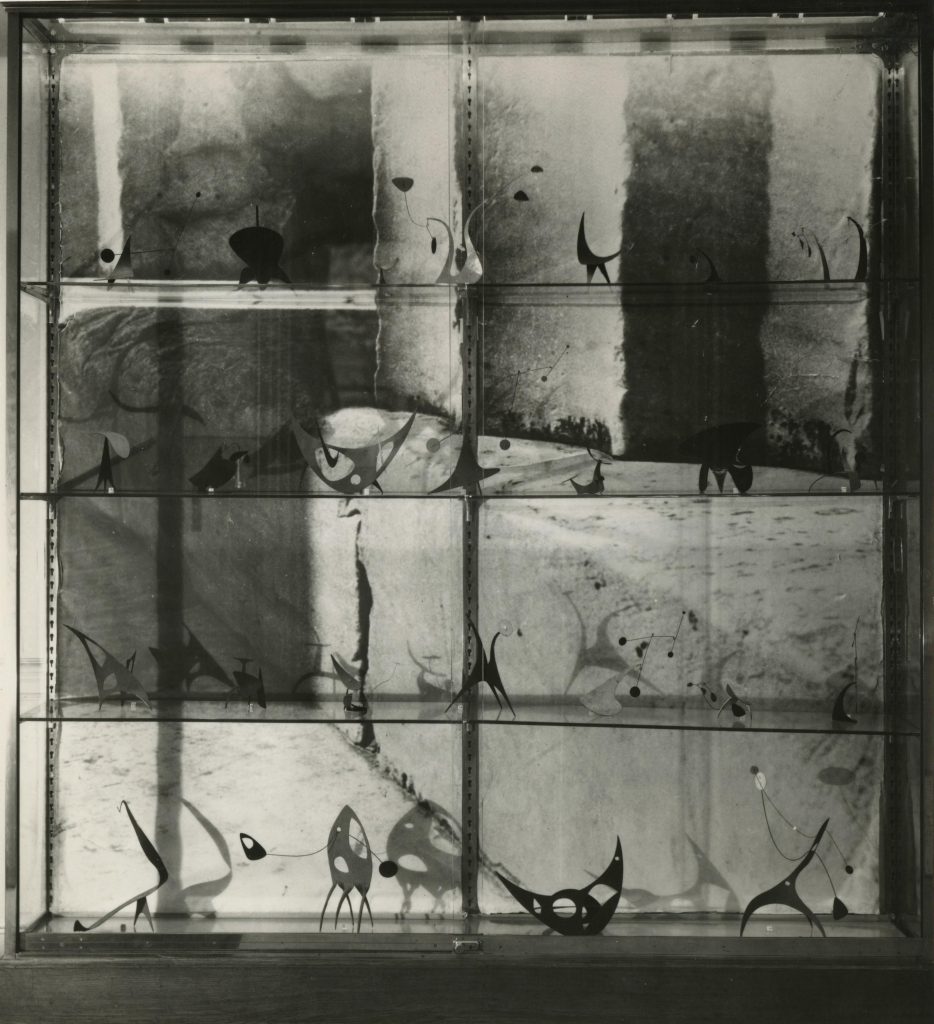
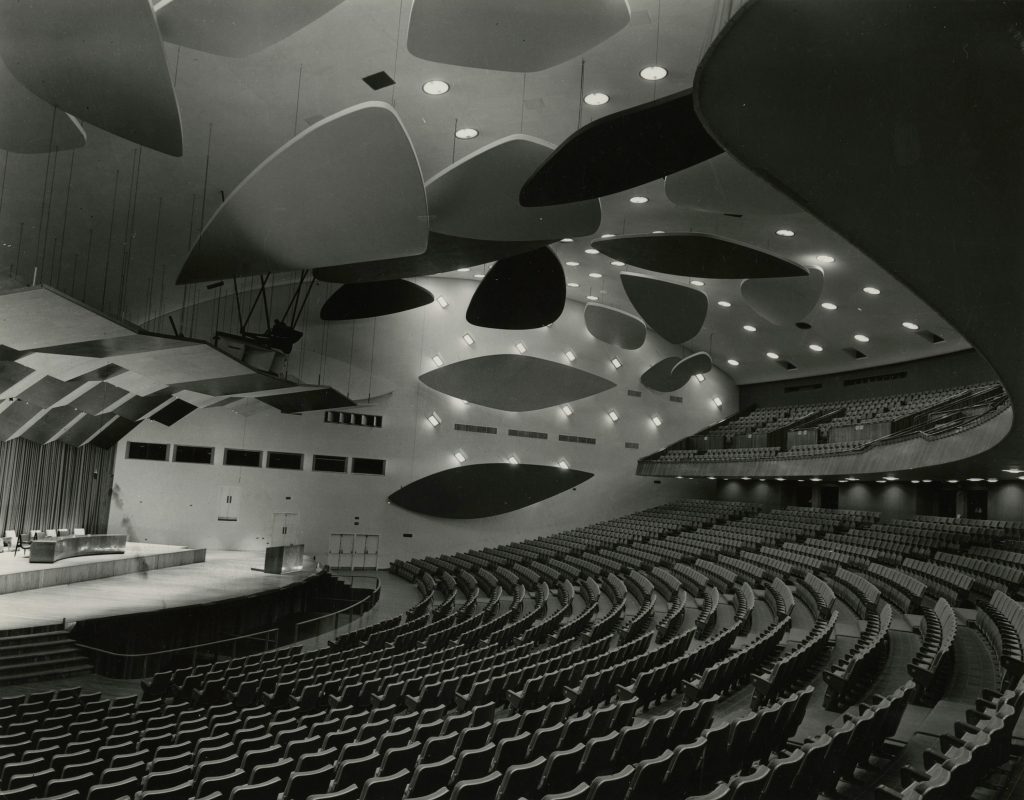
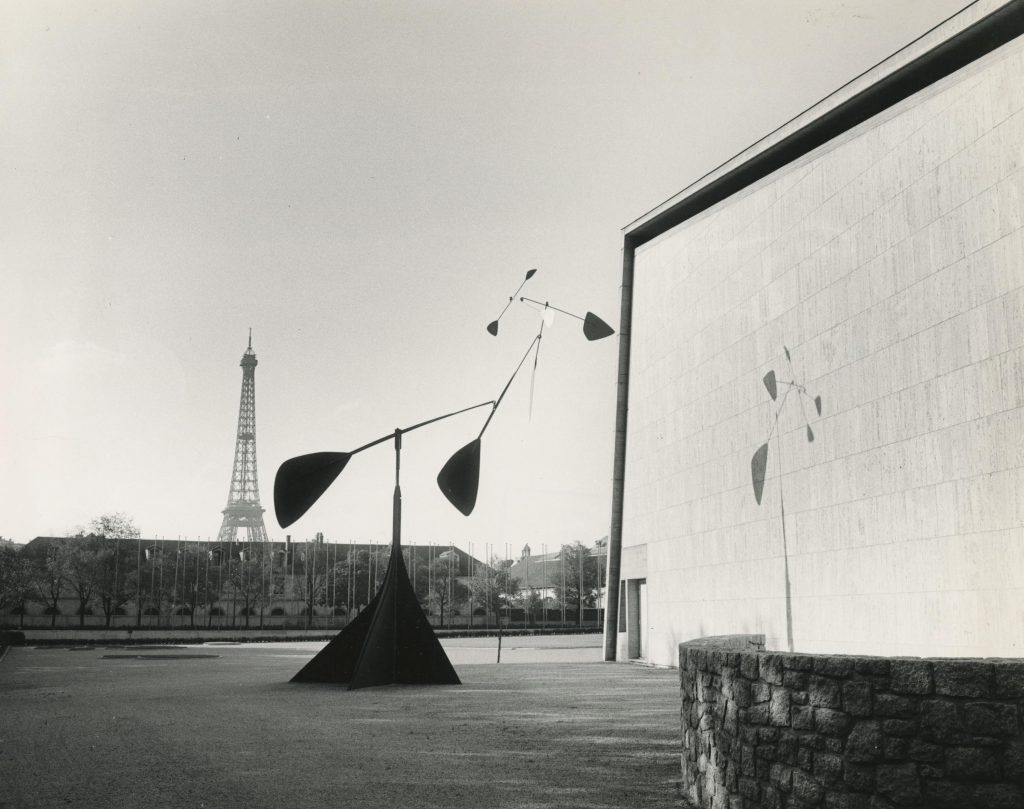
Question: Have American cities influenced you?
Calder: I like Chicago on the Michigan Avenue Bridge on a cold wintry night. There used to be no color but the traffic lights, occasional red lights among the white lights. I don’t think that looking at American cities has really affected me. We went to India and I made some mobiles there; they look just like the others.
Question: What’s happened to that large sculpture, The City?
Calder: The City was purchased by the Museo de Bellas Artes in Caracas through the kind offices of my good friend, the architect Carlos Raul Villanueva.
Question: I found it great. What do you think of it?
Calder: I’m slowly becoming convinced. I made the model for it out of scraps that were left over from a big mobile. I just happened to have these bits, so I stood them up and tried them here and there and then made a strap to hook them together—a little like objets trouvés. [“Found objects” usually refers to articles in nature and daily life, like shells, stones, leaves, torn paper, etc., which the artist recognizes and accepts as art. Ed.] I decided on the final size by considering the dimensions of the room in the Perls Galleries where the work was to be shown.
Question: What artists do you most admire?
Calder: Goya, Miró, Matisse, Bosch and Klee.
Jones, James. “Letter Home.” Esquire, vol. 61, no. 3 (March 1964).
MagazineOsborn, Robert. “Calder’s International Monuments.” Art in America, vol. 57, no. 2 (March–April 1969).
MagazineWhitney Museum of American Art, New York. Alexander Calder: July 22, 1898–November 11, 1976, Memorial Service. Memorial program. 1976.
Unpublished Document or ManuscriptLouisiana Museum of Modern Art, Humlebaek, Denmark. Alexander Calder: Retrospective. Exhibition catalogue. 1995. Louisiana Revy, vol. 36, no. 1 (Summer 1995).
Alexander S. C. Rower, License Plates
Magazine, Solo Exhibition CatalogueDuring a yearlong stay in Aix-en-Provence, Calder executed the first group of large-scale outdoor works and concurrently concentrated on painting gouaches. In 1954–55, he visited the Middle East, India, and South America, with trips to Paris in between, resulting in an astonishing output and range of work. Toward the late 1950s, Calder turned his attention to commissions both at home and abroad.